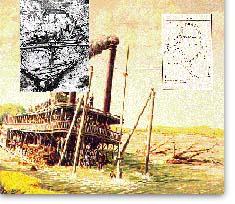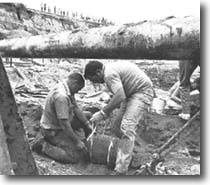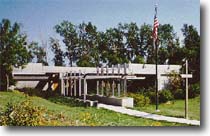Steamboat Bertrand Cargo Collection

DeSoto National Wildlife Refuge, located in Missouri Valley, Iowa, is home to a premier archeological collection of 200,000 artifacts excavated from the buried hull of the Steamboat Bertrand. In 1865 the boat hit a snag, or submerged log, twenty miles north of Omaha, Nebraska. Bound for the newly discovered goldfields of Montana from St. Louis, Missouri, the Bertrand sank into the depths of the Missouri River. Its cargo was a complete loss. Local legend indicated the ship carried whiskey, coins and 500 flasks of mercury to be used in the mining process, a treasure trove worth hundreds of thousands of dollars!
Using historical documents and a flux gate magnetometer, modern salvors discovered the wreck on DeSoto National Wildlife Refuge in 1968. Since the boat's hull was on government property, the
salvors agreed under the requirements of the American Antiquities Preservation Act of 1906, to hand all manmade artifacts over to the U.S. Fish and Wildlife Service for permanent exhibition
and preservation in a public museum.  By 1969, the vessel's extant hull was completely excavated from its thirty feet
deep, mud tomb under the auspices of National Park Service archeologists.
Unfortunately for the salvors, the treasure they sought had
eluded them. Insurance Company divers had removed most of the mercury and other valuables in 1865. In spite of this fact, a diversity of tools, clothing, food, and equipment remained
in the hull. The Bertrand materials were in remarkably good condition, having been preserved in an anaerobic, only slightly acidic, medium. The collection is a goldmine for researchers archeology sites. By 1969, the vessel's extant hull was completely excavated from its thirty feet
deep, mud tomb under the auspices of National Park Service archeologists.
Unfortunately for the salvors, the treasure they sought had
eluded them. Insurance Company divers had removed most of the mercury and other valuables in 1865. In spite of this fact, a diversity of tools, clothing, food, and equipment remained
in the hull. The Bertrand materials were in remarkably good condition, having been preserved in an anaerobic, only slightly acidic, medium. The collection is a goldmine for researchers archeology sites.
 A Visitor Center built by the U.S. Fish and Wildlife Service in 1981, accommodates the artifacts from the Bertrand. A state-of-the-art, collection storage area protects the cargo of A Visitor Center built by the U.S. Fish and Wildlife Service in 1981, accommodates the artifacts from the Bertrand. A state-of-the-art, collection storage area protects the cargo of
the boat. Visitors may view this area through a glass wall, 38 feet in length. A conservation
lab for artifact preservation, collection research area and library are available.
|





